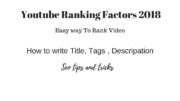To read our blog post about YouTube SEO Tips and Tricks click the link
When done well, not only will the YouTube SEO efforts be effective in getting more viewers and subscribers on YouTube, it will also be effective in getting a high ranking for the videos and/or a YouTube channel on the search engine results page (SERP) of Google.
YouTube SEO Effectiveness is Text-Based and Viewer Interaction
Neither the search engine of Google or the YouTube system has any ability to watch a video. On the other hand, YouTube does have voice recognition software that does a decent job of making a transcript of the audio from the video. This creates the Closed Captioning (CC) feature for those that benefit from being able to read the text while the video is playing, such as people who are hearing disabled.
The CC feature also provides detailed information about what the video says, which Google uses to rank it for its SERP. Therefore, it is important to use the best keywords possible as part of the video script that is said by the video presenter during the video. This must be in a natural way and not “keyword stuffing.” Keyword stuffing is to overuse of keywords that sounds or reads completely unnatural. Google will penalize any video that uses keywords excessively and lowers its ranking. Because of this, be sure to use keywords appropriately to create relevance, but do not overdo it.
Here are some of the tips and tricks recommended by Brian Dean of Backlinko and ourselves, which make YouTube SEO more effective:
Find Effective Keywords
The keywords used for a video on YouTube are the same used by Google to show search results for videos. There are subgroups of searches possible using Google. Entering something in the text box on www.google.com brings up the default text search results. At the top of the SERP, there are also selectable choices for images, videos, news, books, and more.
By clicking on the video subgroup, all the videos related to the keywords come up with the most popular and most relevant listed first. If one wants to get traffic from Google to view a YouTube video or channel, they need to be in the top five listings on the SERP for important keywords or keyword phrases.
Finding the best keywords is sometimes counter-intuitive because ranking high for generic keywords, such as the word “dog” on the SERP is very difficult. It is better to use keyword phrases that are longer, but still get plenty of searches, such as “training your dog to speak.”
Great keyword phrases to use for videos include “How to” in the title. An example would be “How to Train Your Dog to Speak.” Funny and catchy video titles that contain the keywords attract more attention, such as “How to Train Your Dog to Speak French with a British Accent.”
Other popular video categories are tutorials, product reviews, and experiences with services such as travel video blogs that rate hotels and resorts.
Importance of Titles and File Names
It is important to include the keywords in both the title of the video and the file name when uploading the video to YouTube. Do not use only a keyword as a file name for uploading the video file. That results in a penalty for trying to cheat on the YouTube system. Instead, just make sure the file name includes the keywords or simply use the full video title as the file name.
When making the file name use dashes between the words. The Google search engine recognizes dashes as spaces between words. Using our example from above of the title, “How to Train Your Dog to Speak French with a British Accent,” a good file name would be either “how-to-train-your-dog.avi” or “how-to-train-your-dog-to-speak-french-with-a-british-accent.avi” and letter case is not important in file names.
Read More on the Blog
Profiletree Video Marketing Services
Profiletree Content Marketing Services
Profiletree SEO Services
Profiletree Web Design Development/ Services
Profiletree Artificial Intelligence Services
Profiletree Digital Strategy Services
Profiletree Digital Training Services
Profiletree Social Media Marketing Services














